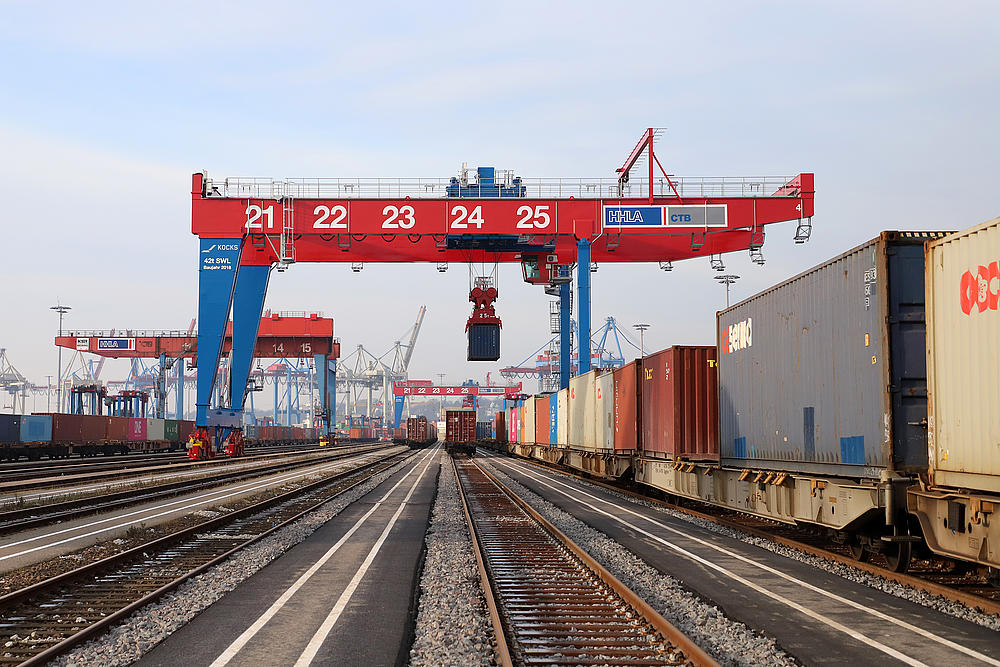22.01.2019
Expansion of the container rail terminal Burchardkai complete
Environmentally-friendly rail transport capacities increased further
Hamburger Hafen und Logistik AG (HHLA) has further increased performance at its largest container terminal in the Port of Hamburg with a comprehensive expansion of its rail terminal.
Two extra tracks and two new rail gantry cranes have been added to the rail terminal at the Container Terminal Burchardkai (CTB), which was one of the largest terminals in Europe even before this expansion. The rail terminal now has ten tracks. It previously had eight. The longest trains permitted (measuring in at 740 metres) can be processed on every track. The second of the new cranes went into operation on 18 January. It is the fourth crane operating on the terminal in total and the final component of the expansion.
Investments in efficient and sustainable cargo transport
CTB Managing Director Andreas Hollmann: “We have expanded our rail terminal once more to provide our customers with more than just extra capacity. The four rail gantry cranes, which work independently of one another, enable more flexible processing and faster reaction times for rail throughput.”
Two rail gantry cranes will serve five tracks each. Two of these cranes have been newly purchased and designed by the manufacturer Kocks Ardelt Kranbau in close cooperation with HHLA. All of the cranes are operated using environmentally-friendly green electricity. Work safety has also been improved. The German Federal Railway Authority contributed towards the costs of the € 13 million expansion project through a programme designed to promote combined traffic.
Around 25 percent greater handling capacity per year
The expansion increases the rail terminal’s capacity by approx. 200,000 standard containers (TEU) to around 850,000 TEU per year. Since 2010, annual rail throughput at CTB has grown by almost 50 percent. Simultaneously, the share of rail transport in the total container volume at the Port of Hamburg increased markedly between 2010 and 2017 from 36.5 percent to 42.8 percent. This makes Hamburg the largest rail port in Europe by far.
The expansion of rail transport capacities at CTB could increase rail’s share in the diverse range of carriers even further in the medium term, explained HHLA Executive Board Member Jens Hansen: “The numerous high-frequency rail connections give the Port of Hamburg a clear advantage against other European ports. We believe rail connections will increase considerably from 2020 through the improved transport connections of CTB. And we are already perfectly prepared for this.”
Once the new Waltershofer road and railway bridges are operational, CTB will not have just one track but two sidings to the Hamburg port railway, and an additional feeder to the CTB rail terminal due to new shunting switches. The project for the additional tracks, which is being managed by the Hamburg Port Authority (HPA), is due to be completed in 2020.
Further investments in the Container and Intermodal segments planned
HHLA also intends to invest in the expansion of its terminal facilities and in the extension of intermodal transport and handling capacities in the future. By 2022, the company intends to invest a total of € 800 million in the Port Logistics subgroup, of which € 450 million has been earmarked for the Container segment and € 350 million has been earmarked for the Intermodal segment. With this investment programme in its core business, HHLA is aiming to further increase its competitiveness and continue to strengthen the company for the future.
Download image

Two new cranes have been newly purchased and designed by the manufacturer Kocks Ardelt Kranbau in close cooperation with HHLA.

